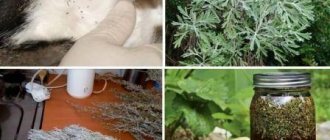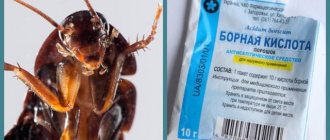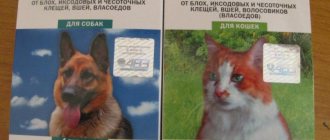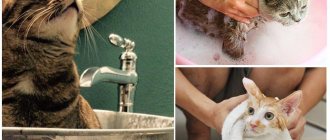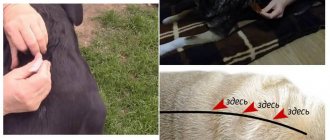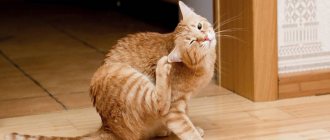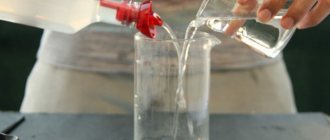Fleas attack both long-haired and short-haired dogs. Insects cause discomfort to animals, are carriers of many diseases, and provoke the development of dermatitis.
It is necessary to provide timely assistance to pets and rid them of parasites. There are many means to repel and destroy bloodsuckers.
Along with pharmaceutical drugs, folk remedies for fleas also give good results.
Recipes and methods
When examining a dog, it is not always possible to see fleas in thick fur. Insects do not always live on the body of the “host”, so it is necessary to act on pests in a comprehensive manner.
The veterinarian gives recommendations on how to combat blood-sucking insects.
He advises using the following means:
- a collar impregnated with insecticides: a pet can wear it for 2-3 months, scaring insects away from itself, but this product is intended for prevention, not treatment;
- anti-flea shampoos, but the effect of their use is short-term, and the product is effective only against a small number of parasites living on the dog; it is not suitable for all pets - it can provoke skin allergies;
- tablets allow you to influence the parasite through the blood, affecting their nervous system, but they are expensive, and it is not always possible to feed this drug to your pet;
- Drops are often chosen from cheap, effective and long-acting drugs, but they can provoke poisoning in the dog, so the insecticide is applied only to the withers of the animal;
- aerosol products can quickly eliminate parasites without harm to the dog; it is recommended to apply it before going outside: the drugs contain toxic substances that can enter the dog’s gastrointestinal tract when licking the dog’s fur and cause poisoning.
If you don’t have such means on hand or you can’t go to a veterinary clinic (pharmacy), you can remove fleas from an animal using improvised methods.
Laundry soap, spicy products, and herbal infusions are usually used. They effectively repel insects, but do not have a long-term effect, so treatment will have to be carried out after 1-2 weeks (depending on the chosen product).
Traditional recipes should be used not only when processing animals. They are also used when cleaning the house, cleaning and washing pet household items. Fleas hide in cracks under baseboards and in other places, so it is worth using complex products.
How does anti-flea cat shampoo work?
If you are interested in how flea shampoo works, the first thing you need to do is read the ingredients. Typically, the active ingredients in insecticidal shampoos are permethrin or its analogues. Natural shampoos are made from essential oils or herbs.
You need to know the following about the action of absolutely all shampoos:
- Insecticidal shampoo eliminates fleas that are currently on the animal.
- All flea shampoos are conditionally dangerous when used externally and are very toxic if swallowed. This condition also applies to natural or herbal shampoos.
- The protective effect of the shampoo lasts as long as its particles are on the coat, usually no more than 2-5 days.
- If a cat's fur smells like shampoo, this does not mean that the protective effect is still there.
- To quickly treat a cat against fleas, if it is not possible to bathe it, you can use a spray.
Tip: if you want to really protect your cat from fleas, and not just eliminate parasites for now, you need to use preventive drops and a collar 3-5 days after bathing.
How to properly wash a cat with flea shampoo?
How to wash a cat with flea shampoo to get rid of parasites and not harm the pet? Each bottle of shampoo has detailed instructions.
If we summarize all the recommendations, we can derive the following set of rules:
- Bathing water should have a comfortable temperature (37–39 degrees).
- The bottom of the basin, sink or other container in which you will bathe the cat should be covered with a towel so that the pet does not slip and start to panic.
- You should have at least two large, absorbent towels ready.
- Before applying shampoo, it is better to dilute it in a small bowl of water.
- To prevent fleas from getting into your pet's eyes, ears and mouth, lather his neck before immersing himself in water.
- Keep the foam on the animal for at least 5 minutes; if necessary, wrap the cat in a towel and carry it in your arms for a while.
- Rinse off the foam thoroughly with running water until no more bubbles form on the wool.
After bathing, the cat must be thoroughly dried or dried with a hairdryer. Even if you use phyto-shampoo, make sure that the cat does not lick itself after bathing. Most active ingredients lose acute toxicity after the wool dries.
How often can you wash your cat with flea shampoo?
Most shampoos help quickly get rid of inconvenience and discomfort. A cat can quickly become infected with parasites again, and the owner has a logical question: how often can a cat be washed with flea shampoo?
Frequently bathing a cat is harmful to the health of its skin and coat, even if insecticidal shampoo is not used. If absolutely necessary, the cat can be bathed three or four times in a row at intervals of 1–2 days. Such measures are relevant when treating subcutaneous mites or other parasites.
Is it possible to wash a pregnant or lactating cat with flea shampoo?
If you need to treat a pregnant cat for fleas, most veterinarians will advise you to use Stronghold drops. The drug is considered unique because its use does not harm embryos at any stage of gestation. If for some reason the use of drops is impossible, a pregnant cat can be rid of fleas using folk remedies.
If it is necessary to treat a nursing cat for fleas, bathing it is strictly contraindicated, since the remainder of the active ingredient in the shampoo will in any case remain on the fur.
Kittens that are fed their mother's milk will be exposed to the insecticide, resulting in distress. A universal remedy for the prevention of fleas in a nursing cat is Advantage drops. According to the manufacturers, the drops protect not only the cat from parasites, but also the place where it sleeps, that is, the nest in which the kittens are constantly located.
Green pharmacy: herbs for parasites
The negative effect of some plants on insects has been noticed for a long time: the pungent odor emitted by herbs repels pests.
Tansy and wormwood are the most effective in fighting fleas. The pests do not tolerate eucalyptus and hellebore. Do not forget that hellebore is a poisonous plant, so you need to handle it with care.
It is important to follow the dosage. It must be selected individually depending on the breed and body weight of the pet.
It is not recommended to use decoctions to remove parasites from nursing bitches: the aroma of the grass can drown out the mother's smell and scare away puppies.
How to use the herb
Scented plants are used to prepare infusions and decoctions. For the product to be effective, you should take fresh herbs.
Procedure:
- raw materials are crushed;
- take 40 g and pour boiling water (1 l);
- Cover with a lid and leave for 30 minutes.
The strained infusion is used for bathing the dog (the liquid is thoroughly rubbed into the pet’s skin). The composition will not kill insects, but will repel them.
Expert opinion
Makarenko Svetlana Igorevna
Practicing veterinarian, 15 years of experience.
If you only have dried herbs on hand, it is better to make a decoction. For this, 3 tbsp. raw materials are poured with boiling water (0.5 l) and brewed on fire for 2-3 minutes, then infused.
The decoction is concentrated, so it is diluted with water before use.
You can use the prepared liquids not only to bathe your pet, but also to wash the floor with them, treat furniture, dog bedding, toys and other items.
Another way to use herbs: freshly picked bunches of plants are laid out along the baseboards (and if the floors are wooden, then over the entire surface), under the furniture and pet’s bed, near his toilet and bowls. As the grass dries out, replace it with fresh bunches.
What herbs repel fleas in the house
In a private home, you can protect yourself from fleas by planting plants that repel insects. This is a good preventive measure against pest invasion.
Plant lavender along the path to the house or in the sunny side of the garden. Lilac flowers will be an excellent decoration and an obstacle to fleas.
They have repellent properties:
- peppermint;
- rosemary;
- noble laurel;
- fragrant rue;
- black elderberry;
- oregano;
- garlic;
- calamus;
- Melissa.
Decorative flowers look good around the house, on the veranda and balcony. To protect your home from insects, plant marigolds, chrysanthemums, nasturtiums, petunias, and geraniums. The smell of these plants repels not only fleas, but also mosquitoes, ticks, and beetles.
Laundry soap with eucalyptus
This detergent is a real “lifesaver” in many everyday situations. Therefore, it is always recommended to keep it in reserve. So in the fight against fleas on a dog, laundry soap turns out to be useful.
You can use it yourself instead of shampoo to bathe your pet.
To enhance the effect, it is better to use this recipe:
- take several eucalyptus leaves and boil them;
- cool, add 2 drops of strong-smelling ether (pine, fir, cedar, tea tree);
- A bar of laundry soap is ground on a grater and added to the prepared composition.
The resulting solution is thoroughly rubbed into the animal’s fur, left for several minutes and washed off with warm water. If eucalyptus is not available, you can add a little essential oil of this plant to the soapy water.
Causes and symptoms of fleas in cats
Fleas appear in cats when they are infected by other animals. In this case, there may not be direct contact. Parasite larvae can be carried home on shoes. After getting on the pet’s fur, they quickly hatch and actively reproduce. Fleas can cause dermatitis, in which the cat begins to itch, characteristic rashes and damage to the skin appear. Such parasites feed on the capillary blood of the animal, and their saliva is a strong allergen that provokes the described reactions.
Fleas in cats can multiply quickly and cause itching.
Fleas are very easy to recognize. If they are present, the pet itches all the time and may shake its head. Most cats experience decreased appetite, weight loss, and sleep disturbances. In addition, fleas are carriers of helminths, which provoke severe disturbances in the functioning of the pet’s body. To detect parasites, just move a few hairs apart
Particular attention should be paid to the withers area; as a rule, there are the most fleas there. The parasite resembles a black or brown miniature midge that jumps high and also moves very quickly
The flea feeds on the pet's capillary blood
Garlic is a bloodsucker repeller
Just like herbal scents, fleas do not like garlic scents.
At home, the following infusion is often used:
- chop 2-3 cloves (on a grater or using a crusher);
- pour a glass of water;
- leave for 12 hours.
It is better to prepare the product in the evening so that you can use the prepared solution in the morning. Garlic infusion is rubbed into the skin of the animal, but this is done with caution.
You should choose those places on the body where the dog cannot reach with its tongue. If it enters the digestive system of an animal, the spicy solution can cause serious health problems, including death.
Treating cats with soap
Cats are very finicky creatures who do not like to take baths. If households who do not go outside are unlikely to catch any infection, then street revelers are very susceptible to this, and after each walk they need to be washed and treated. After all, if they have worms, people can also become infected with helminthiasis.
Cats have a special relationship with water: don’t touch this wet liquid! There are, of course, exceptions who love to swim, but they are too few.
Some cats favor baths
Therefore, washing a water hater usually requires two adults - one holds it, the other washes it. In addition, you must follow a number of rules for bathing cats:
- before bathing, you need to heat the bath so that it is not cold, and fill it with water so that it is up to your pet’s chest;
if you have a basin, fill it with warm (38–43 degrees) water (so that it only reaches the cat’s chest) and place the cat in it; Do not wash in a cold bath or with cold water - the pet may get sick; The cat must stand firmly on its paws, the water must be up to its chest, not higher, so as not to choke. - water should not get into the ears, eyes, nose and mouth; It is quite enough to wash the entire body except the head;
- you need to be extremely careful with the stomach - this is a very delicate area, behind which vital organs are located, and powerful jets of water into this area can trigger the animal’s instinct of self-preservation;
The stomach of cats is a very delicate and important area, you need to be very careful with it, especially if you wash the cat from the shower - some cats are very restless in the water: they can break out, some reach the taps with their paws and can accidentally turn them, trying to get out, this should not be allowed - either the water will be too hot or too cold, which will harm both the animal and you;
A frightened cat can easily turn on the taps and let in very hot or too cold water. - after the bath, the cat must be wrapped in its own towel so that the water is absorbed into it;
The less water on a cat's fur, the faster it will dry and the less likely it is to get sick. - place the pet in a warm place (to the radiator, pick it up or send it to the balcony under the hot rays of the sun) - it should not freeze;
These are the basic rules for bathing a cat. As for the actual washing, everything is quite simple:
- First you need to wet the animal’s fur (you don’t have to touch the head).
- Lather the bar of soap until it lathers.
- Rub the wool with this foam. Soap should not get into the mouth, nose, ears and eyes; To do this, do not wash your pet’s head, keep it elevated so that foam from the neck does not get into the mouth.
- Wait 3-5 minutes for the soap to take effect. The pet should not lick itself at this time - if soap enters the body, it will cause poisoning.
- Rinse off the foam thoroughly.
- Wrap the cat in a towel and let him warm up.
If laundry and tar soap can be used for pregnant and lactating cats, then dust soap should absolutely not be used for them.
Small kittens (up to a month) cannot be washed with any soap, and dust can only be used after one and a half months.
Cats should be washed with laundry or tar soap at least twice with a 4-7 day interval between procedures. If you use dust soap, once is enough.
Onions and tar soap
The plant's properties are identical to garlic and have a good repellent effect. The onion is crushed to a pasty state and poured with a glass of water. To enhance the effect, it is advisable to add tar or laundry soap.
The product is thoroughly whisked and can be immediately applied to the dog’s body. The processing is carried out with caution, as is the garlic infusion. After a few minutes, the soapy-spicy composition is washed off.
Apple cider vinegar is a helper in getting rid of fleas
In its pure form, this product cannot be used on animals.
Therefore, before use, vinegar is diluted with water at room temperature at the rate of 1 part vinegar to 3 parts water. The resulting solution is generously treated with the animal’s body (entirely) and left for 1 hour. The pet is then bathed and combed with a fine-tooth comb to remove paralyzed insects.
Treating the premises with folk remedies
In addition to herbs and essential oils, there are many non-traditional remedies for flea control.
Boiling water
This method can kill fleas: too high temperatures are harmful to insects.
Knowing the places where jumping bloodsuckers accumulate, it is easier to fight them. The animal's bedding and the surrounding area are treated with boiling water.
If the baseboards and floors in the house are wooden, you can walk on them. The dog kennel should also be poured with hot water on all sides.
Kerosene
This product is used to treat all surfaces in the house where insects may be present. To ensure the death of fleas, it is advisable to rub kerosene at least 2 times a day.
Note ! No matter how effective the remedy is, it does not affect egg laying.
Therefore, in order to completely destroy parasites, the premises will have to be treated with kerosene for a month in order to get rid of the insect larvae that will hatch during this period.
Fleas? Very bad…
The flea is a person’s most faithful and constant companion in life. We have been unable to get rid of this little creature for many millennia. Hordes of her ruthless accomplices occupy our homes to this day, causing a lot of problems and by no means minor troubles for both people and their pets - dogs and cats.
Is it really impossible to get rid of fleas once and for all?
It turns out that it's not that simple. Ectoparasite insects, which include fleas, are incredibly resilient and adaptable. One destroyed one is replaced by thousands of new blood-sucking creatures. Up to two thousand species of fleas are known, about sixty of which live in our latitudes. They live not only on domestic animals, but also in human homes: in cracks in the floor and walls, carpets, upholstered furniture, clothes, annoying both people and their pets with bites. Such a neighborhood causes a lot of trouble, and in advanced cases, it is possible to evict uninvited tenants only with the help of a complete sanitary treatment of the house.
The first symptom of a flea infestation is that the animal begins to become restless, chewing and scratching furiously in areas where it feels itchy from flea bites. Examine your pet's fur and skin - you will definitely notice, if not the parasites themselves, then traces of their presence: eggs or excrement. In advanced cases, the animal develops dermatitis, weeping eczema that is difficult to treat, and alopecia. Small puppies and kittens are especially affected by fleas.
Considering that fleas carry pathogens of up to three dozen diseases dangerous to humans, the question of how to get rid of parasites is very important. Serious infections and parasitic problems are transmitted through the bites of these blood-sucking insects:
Even if there is no infection, flea bites are very unpleasant for humans in themselves: they cause itching, redness, and severe allergic reactions.
It's good that they are small...
When magnified many times, the baby flea looks like a monster from a science fiction horror movie.
Imagine for a moment that the flea has grown to at least the size of a cat - it’s better not to think about the scale of a tiger. And if you also take into account the flea’s ability to jump to a height almost three hundred times greater than its own size...
The flea does not live long, but it is fruitful: in two years, the female manages to give birth to up to five hundred similar individuals, each of which, within a month after birth, also begins to actively reproduce and reproduce.
The nimble blood-sucking insect has perfectly adapted to a parasitic lifestyle. A flea maneuvers through animal fur like a snake in the jungle. It is very difficult to catch it, and once caught, crush it: the flattened body of the small parasite is reliably protected by a hard chitinous shell. Neither a dog nor a cat is able to cope with the invasion of bloodsuckers. How to help your pet?
What to do with them?
Wash, vacuum, freeze. Frequent cleaning of the room with washing and vacuuming is, of course, a preventive measure. But by creating unfavorable conditions for the existence of fleas, it will prevent parasites from feeling at ease on your territory.
And the fact that the territory itself will become much cleaner and more comfortable - well, take this as a pleasant bonus of your war. After all, in everything bad there must be at least something good...
Ventilate the room more often, especially in winter - these small creatures love not only comfort, but also warmth, and cannot stand the cold at all!
Brush your animals every day. Daily brushing of your pet's fur with a fine comb helps mechanically remove fleas. Of course, this should be done on a walk, not at home. The procedure will not get rid of parasites completely, but in combination with other means, the unpleasant problem will be solved.
And the fur of your dog or cat will look better, more well-groomed, and the house will be cleaner.
It is better that the comb is metal, and its teeth are hard and as frequent as possible. But even daily combing will not remove all adult parasites and their eggs from the fur, and the procedure will definitely not stop new fleas.

